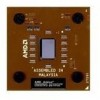AMD AXDA3200DKV4E Data Sheet - Page 87
FSB_Sense[1:0] Pins, FLUSH# Pin, IGNNE# Pin, Table 26., Front-Side Bus Sense Truth Table
 |
View all AMD AXDA3200DKV4E manuals
Add to My Manuals
Save this manual to your list of manuals |
Page 87 highlights
26237C-May 2003 Preliminary Information AMD Athlon™ XP Processor Model 10 Data Sheet FSB_Sense[1:0] Pins FLUSH# Pin IGNNE# Pin INIT# Pin signals High above 2.5 V. Do not expose these pins to a differential voltage greater than 1.60 V, relative to the processor core voltage. Refer to "VCC_2.5V Generation Circuit" found in the section, "Motherboard Required Circuits," of the AMD Athlon™ Processor Motherboard Design Guide, order# 24363 for the required supporting circuitry. See "Frequency Identification (FID[3:0])" on page 25 for the DC characteristics for FID[3:0]. FSB_Sense[1:0] pins are either open circuit (logic level of 1) or are pulled to ground (logic level of 0) on the processor package with a 1 kΩ resistor. In conjunction with a circuit on the motherboard, these pins may be used to automatically detect the front-side bus (FSB) setting of this processor. Proper detection of the FSB setting requires the implementation of a pull-up resistor on the motherboard. Refer to the AMD Athlon™ Processor-Based Motherboard Design Guide, order# 24363 and the technical note FSB_Sense Auto Detection Circuitry for Desktop Processors, order# TN26673 for more information. Table 26 is the truth table to determine the FSB of desktop processors. Table 26. Front-Side Bus Sense Truth Table FSB_Sense[1] 1 1 0 0 FSB_Sense[0] 0 1 1 0 Bus Frequency RESERVED 133 MHz 166 MHz 200 MHz The FSB_Sense[1:0] pins are 3.3-V tolerant. FLUSH# must be tied to VCC_CORE with a pullup resistor. If a debug connector is implemented, FLUSH# is routed to the debug connector. IGNNE# is an input from the system that tells the processor to ignore numeric errors. INIT# is an input from the system that resets the integer registers without affecting the floating-point registers or the internal caches. Execution starts at 0_FFFF_FFF0h. Chapter 11 Pin Descriptions 75















